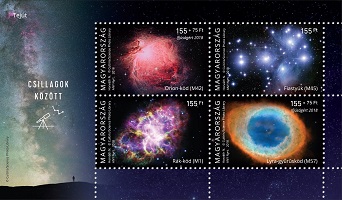
Ifjúságért - Csillagok között - Bélyegblokk
2018-ban az ifjúsági bélyeggyűjtés támogatására megjelenő feláras bélyegkisív témája a világegyetem, amelyen a Tejútrendszer változatos alakzataiból válogatunk. Az újdonság két címletéhez kapcsolódó felár összegét, összesen 150 Ft-ot a Magyar Posta az ifjúsági bélyeggyűjtés támogatására fordítja. A 30 000 példányban megjelentetett kisív Horváth Nóra grafikusművész tervei szerint az ANY Biztonsági Nyomdában készült. A kiadvány 2018. május 2-án jelenik meg, és ettől az időponttól kezdve kapható az elsőnapi postákon, a Filapostán, továbbá megrendelhető a Magyar Posta internetes áruházából is.
A Föld, a Nap és a Hold – három égitest, melyeket mindnyájan ismerünk. Azonban a nagyvárosok éjszakai égboltján ma már alig észrevehetők a bolygók és a csillagok. Ahhoz, hogy saját galaxisunk, a Tejútrendszer is feltűnjön az égen, el kell hagynunk a városokat. Ám a derült, csillagokkal teli éjszakai égbolt látványa ma is lenyűgöző – éppúgy, ahogyan őseink számára is az volt, akiknek képzelete hősökkel és mitológiai lényekkel népesítette be az eget. Ez a látvány akkor válik igazán döbbenetessé, ha valaki teleszkópon keresztül vizsgálódik, hisz a legmodernebb eszközökkel milliárdnyi csillag képe jelenik meg. A kisív címletein a Tejútrendszerben található négy látványos jelenséget örökítettünk meg. Valamennyi a csillagok életútjának egy-egy állomásába enged betekintést.
Az első címleten az Orion-köd látható, amit lenyűgöző színei emelnek az égbolt egyik leghíresebb látványosságává. A Földtől 1500 fényévre lévő ionizált hidrogénből álló gázködöt a benne található Trapéziumnak nevezett nagy tömegű csillagcsoport gerjeszti fénylésre. A forró és fiatal Trapézium-csillagok üreget fújtak a porrétegben és megvilágítják a környező anyagot. A köd egyes területein napjainkban is keletkeznek újabb és újabb csillagok.
A második címleten a Bika csillagképben található Fiastyúk (Plejádok) nyílthalmaz tekinthető meg. A mintegy 440 fényévnyi távolságra található halmaz szabad szemmel is látható hét csillagát már a görög mitológia is megszemélyesíti, az Ószövetségben is említést tesznek róla, sőt a magyar mondákban is szerepel. Az objektum a valóságban – mai tudásunk szerint – több száz csillagból áll. A nyílthalmazok, így a Fiastyúk is, fiatal csillagok alkotta csoport, melyek egy hatalmas gáz- és porködben jöttek létre, de az évmilliók múlásával egyre távolodnak egymástól.
A harmadik címleten a Földtől 6500 fényév távolságban fekvő Rák-köd található. 1054-ben kínai és arab csillagászok megfigyeltek egy 23 napon át látható új, fényes csillagot az égen. Valamivel kevesebb, mint egy évezreddel később jöttek rá, hogy a jelenséget egy nagytömegű csillag életének végét jelző esemény, a szupernóva-robbanás okozta, a korábbi csillag felrobbant maradványa a Rák-köd. A köd a nevét onnan kapta, hogy a 19. században a kezdetleges eszközökkel vizsgált objektumról készült rajzokon a megörökített látvány nagyon hasonlított egy rákra.
A negyedik címleten az egyik leghíresebb planetáris ködöt, a 2300 fényévnyi távolságban lévő, Lant csillagképben található Lyra-gyűrűsködöt mutatjuk be. Ez a látványos objektum a középpontjában elhelyezkedő halvány, fehér törpecsillag által ledobott gázburokból alakult ki. Életútja végén Napunk – évmilliárdok múlva – ún. vörös óriássá alakul, felfúvódik, külső rétegeit leveti magáról, és a helyén egy Földhöz hasonló méretű fehér törpecsillag alakul ki, körülötte pedig a Lyra-gyűrűsködhöz hasonló jellegzetes planetáris köd tűnik fel. A ködről, 1886-ban, Gothard Jenő magyar csillagász készített először fotografikus felvételt, aki egyúttal a köd közepén található csillagot is felfedezte.
A kisív bal oldalán a Tejút látható, illetve a Cassiopeia csillagkép sematikus ábrája jelenik meg. A bélyeghez kapcsolódó alkalmi boríték és bélyegző hangulatában is utal az emberiség és a csillagok közötti űr még felfedezetlen rejtelmeire.










